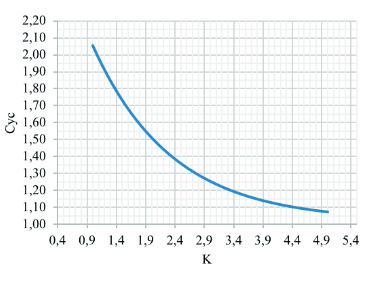Numerical study for the estimation of the hydrodynamic coefficients of current drag in port assistance maneuvers (dock) for the Colombian Navy frigates by means of CFD
DOI:
https://doi.org/10.25043/19098642.233Keywords:
CFD, Current draft coefficient, STAR-CCM , OCIMF, ITTC, Bollard pullAbstract
Computational Fluid dynamics (CFD) has become nowadays an important tool in the process of hydrodynamic design of modern ships. CFD is used to model any phenomena related to fluid flow in a control volume like a ship or any offshore structure in the sea. In the present study, the Current force drag coefficients for a Colombian Navy Frigate in deep and shallow water are estimated through application of CFD, which are required to estimate the bollard pull for assisting maneuvers at port. The study shows the process of simulating the ship current drag coefficients using the CFD simulations method which is conducted using STAR-CCM+ software package. The Almirante Padilla class Frigate ship CFD scale model is investigated. The results show the ship current drag coefficient calculated considering a current speed of 1 knot with a 90° drift angle for the full-scale ship. The model configuration of the present simulation is based on the procedure recommended and published in the Lloyds Register OCIMF and the UFC mooring report for the estimation of the current drag coefficient.
Downloads
References
H. HENSSEN, "Tug Use in Port: A Practical Guide," The Nautical Institute, Second Edition, 2003. pp. 69-77.
Department of Defense USA, Unified Facilities Criteria, UFC 4-159-03 Moorings, 2020, pp 54.
DNV, "Recommended Practices DNV-RP-H103- modelling and analysis of marine operations", DET NORSKE VERITAS, 2011, pp 103, pp 28 .
LOTHAR BIRK, Fundamental of ship Hydrodynamics, John Wiley & Sons Ltd,2019. https://doi.org/10.1002/9781119191575
David Le Touzé, Introduction to numerical simulation - Lecture Notes, Fluid Mechanics Lab, Ecole Centrale Nantes / CNRS, 2015.
E. PEÑA, et al, "Estudio de prefactibilidad ambiental y social sobre la construcción de un puerto de aguas profundas en Bahía Málaga, Pacífico colombiano", Universidad del Valle, Cali, 2010, pp 31.
E. A.J. VROEGRIJK, OCIMF, "CFD current drag" Lloyds Register, Technical Investigation Department, 2017.
A. KOOP, "Shallow water current loads on a LNG carrier using CFD" Proceedings of the ASME 2015 34th International Conference on Ocean, Offshore and Arctic Engineering, 2015. https://doi.org/10.1115/OMAE2015-41275
Oil Companies International Marine Forum (OCIMF), "Prediction of wind and current loads on VLCCs". 2nd edition, 1994.
ITTC, "Practical Guidelines for Ship CFD Applications, " International Towing Tank Conference, 2011.

Published
How to Cite
Issue
Section
License

This work is licensed under a Creative Commons Attribution 4.0 International License.
The authors who publish in this Journal certify that:
- The work submitted for publication in The Ship Science and Technology journal, was written by the author, given that its content is the product of his/her direct intellectual contribution.
- All data and references to material already published are duly identified with their respective credits and are included in the bibliographic notes and quotations highlighted as such.
- All materials submitted for publication are completely free of copyrights; consequently, the author accepts responsibility for any lawsuit or claim related with Intellectual Property Rights thereof, Exonerating of responsibility to The Science and Technology for the Development of Naval, Maritime, and Riverine Industry Corporation, COTECMAR.
- In the event that the article is chosen for publication by The Ship Science and Technology journal, the author state that he/she totally transfers reproduction rights of such to The Science and Technology for the Development of Naval, Maritime, and Riverine Industry Corporation, COTECMAR.
- The authors retain the copyright and transfer to COTECMAR the right of publication and reproduction of the work which will be simultaneously subject to the Creative Commons Attribution License (CC -BY) , which allows the license to copy, distribute, display and represent the work and to make derivative works as long as it recognizes and cites the work in the manner specified by the author or licensor.
- For more information about the Creative Commons Attribution License (CC -BY) and his use and scope, please visit the following web page https://creativecommons.org/licenses/by-sa/4.0/legalcode








